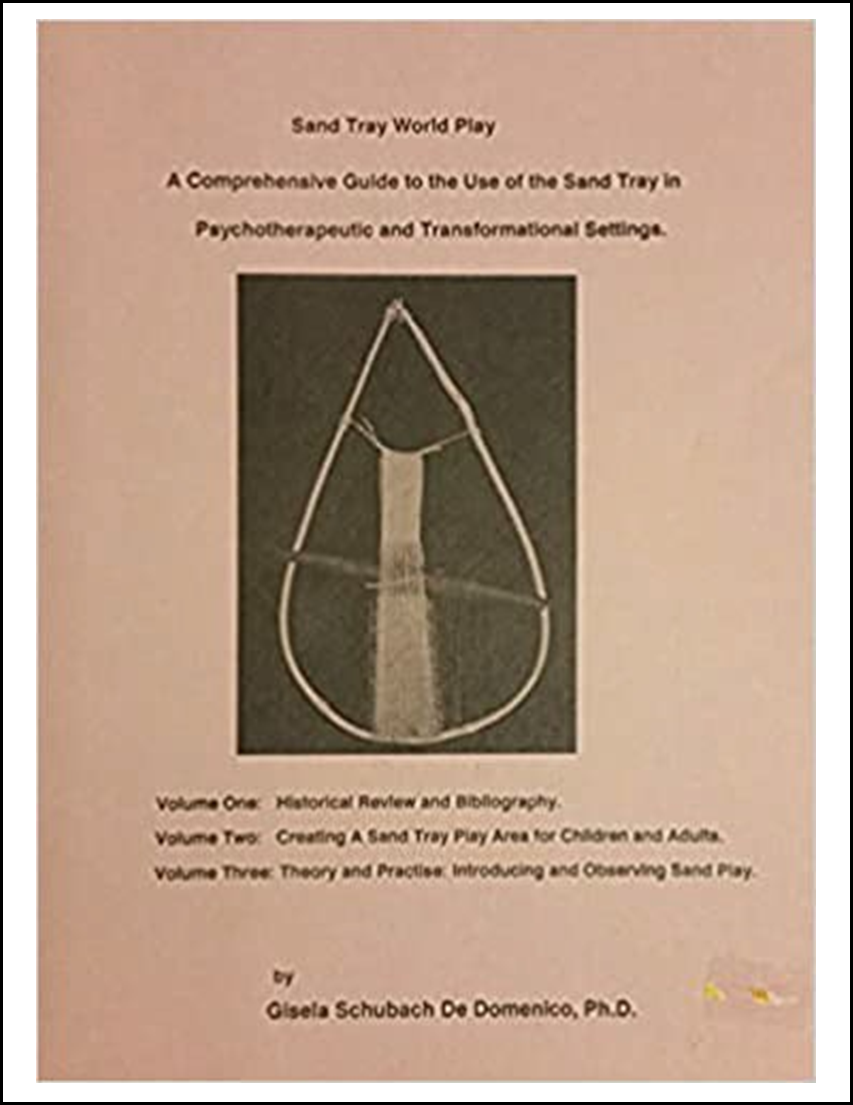
Sand Tray World Play: A Comprehensive Guide to the Use of the Sand Tray in Psychotherapeutic and Transformational Settings
Rita Grayson
U.S.A.
https://doi.org/10.58997/wjstp.v1i4.26
It is my pleasure to offer an introduction to this book which captures the life work of Gisela Schubach De Domenico, Ph.D., creator of the Sandtray-WorldplayTM method of sand therapy. Sadly, this self-published work is now out of print, although it is still possible to find used copies from time to time. In her study of sand therapy, Dr. De Domenico noticed an emphasis on the finished sand world creation. She contributed to our field by expanding awareness to the importance of every moment of the world creation process and offering guidance in using sand therapy with couples, families, and groups. I was fortunate to obtain this book when I began my study with Dr. De Domenico in 2005. My copy consists of three volumes and numerous articles (listed below) and was last updated in 2000. There may be previous or subsequent editions, although my copy is not designated with an edition number.

Volume One: Historical Review and Bibliography (1988) offers Dr. De Domenico’s perspective on the nature of sand tray play, which emphasizes the non-verbal “bridge between an individual’s unique intrapsychic reality and the reality of the outer world” (Vol. 1, p. 1). This volume includes a description of the sand tray equipment used by Dr. Margaret Lowenfeld and Lowenfeld’s rationale for offering sand tray therapy to the children she served in her clinic. As the title indicates, this volume concludes with an accounting of the development of sand therapy, beginning with Lowenfeld in the 1920s and continuing into the 1980s.
Volume Two: Creating a Sand Tray Play Area for Children and Adults: A Manual for Psychotherapists, Teachers, and Those Who Use Symbols and Images for Healing (1988) dives into the practical aspects of offering sand therapy, including details about size, shape, and placement of trays, types of sand, as well as some practical advice about clean-up. No discussion of equipment would be complete without a thorough discussion of the sand therapy collection, which De Domenico refers to as a “miniaturized universe where the self, the soul, the psyche, and the body of the player are invited to act out the role of the creator” (Vol. 2, p. 43). She provides a comprehensive list of figures and some thoughts about how to display them; De Domenico also offers the reader her reflections about curating a sand therapy collection.
Volume Three: Theory and Practice: How to Introduce Sand Tray Play to the Client and The Art of Observing Sand Tray Play moves us into the process of sand therapy. In the first section, De Domenico offers her rationale for using sand therapy in different ways with various clients. She discusses free and spontaneous play (allowing the client to use the materials in any way they feel drawn) with individual adults and children, couples, families, and groups. For each of these types of sessions, De Domenico gives us pages of insight into the process unfolding in the sessions and considerations for the therapist to keep in mind while holding and honoring the process. This volume also explores conditions in which the sand therapist may want to offer a more directed experience, with suggestions for how to do so.
The second section of Volume 3 addresses the art of witnessing sand therapy creations, which De Domenico describes as a complex, multi-layered process. She distinguishes between the factual observer - the part of the sand therapist who is mentally noting what is happening in the session - and the observer-witness who “teaches the builder that the activity of the moment has intrinsic meaning, is more sacred than mundane and more meaningful than meaningless” (Vol. 3, p. 44).
Section three of this volume addresses ways to record what takes place in a sand therapy session, and section four describes the different phases of a Sandtray-WorldplayTM session.
In addition to the three volumes, my copy of this book includes the following articles:
- Sandtray Worldplay: A Psychotherapeutic Technique for Individuals, Couples and Families(1992)
- A Child’s Sandtray Play Mirrors the World of her Father: Applications of the Lowenfeld World Technique: A comparative Illustration of the Analysis of the Final World and the Analysis of the Sand Tray Play Process (1986)
- Sandtray Worldplay with Couples: Applications and Techniques (1991)
- Voices from the Past: John Hood-Williams and the Sandtray: Selection and Commentary
- A Comprehensive Bibliography of the Sandtray-, Sandplay- and Sandtray-Worldplay Therapy Literature, Compiled and updated in 2000.
I had the privilege of studying directly with Dr. De Domenico. Her genius and passion for this work fills my heart and mind as I read this text. For those who have not had the good fortune of knowing Dr. De Domenico, this book may be challenging to read because it can take time to orient to the perceptual lens through which it is written. The effort is worth it because once you drop into the mindset that gave birth to the Sandtray-WorldplayTM method, you will find treasure on every page!
Reference:
De Domenico, G. S. (2000). Sand tray world play: A comprehensive guide to the use of the sand tray in psychotherapeutic and transformational settings. Vision Quest Images.
© World Association of Sand Therapy Professionals, Volume 1, Number 4, 2023